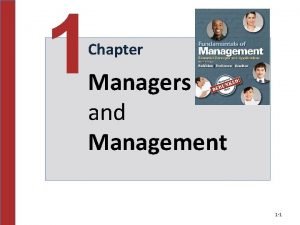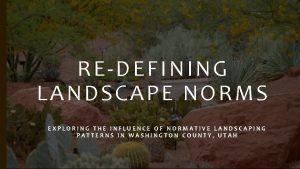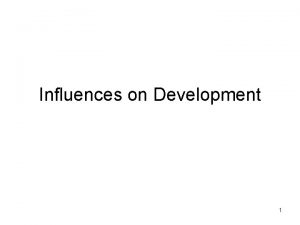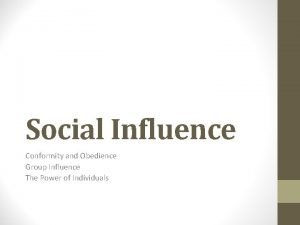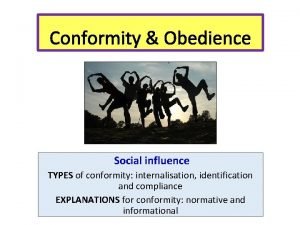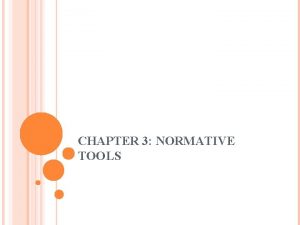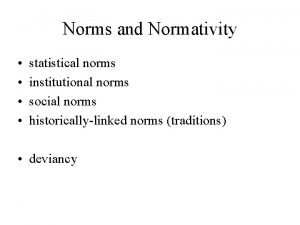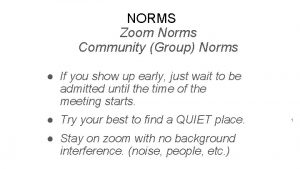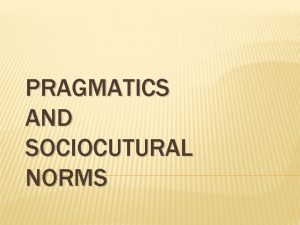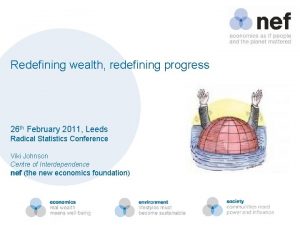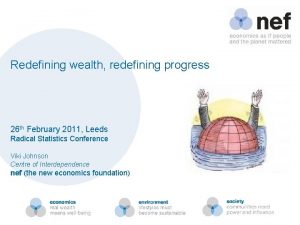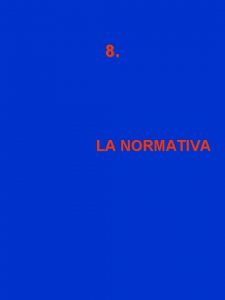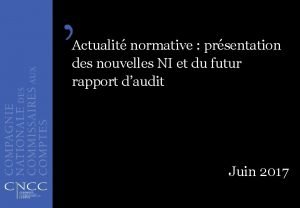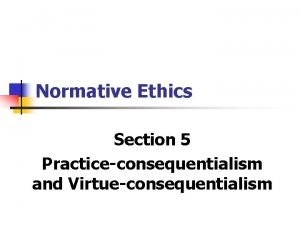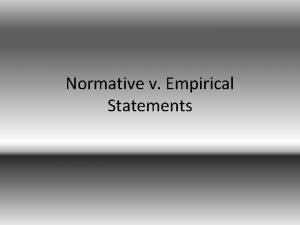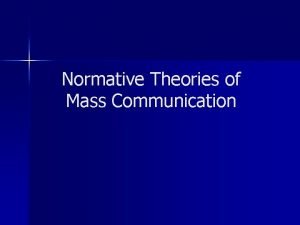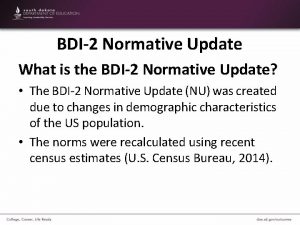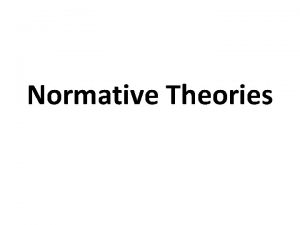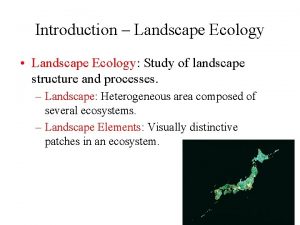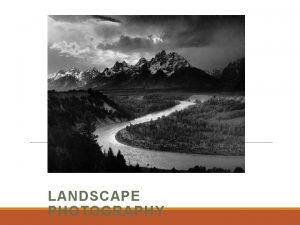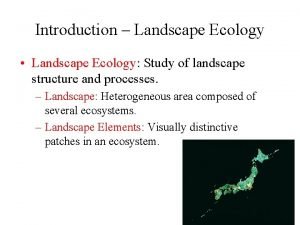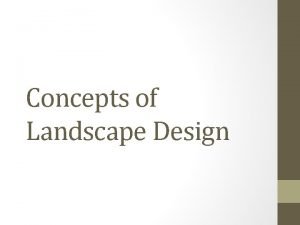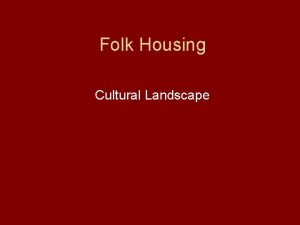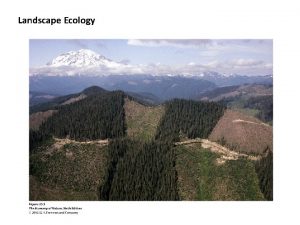REDEFINING LANDSCAPE NORMS EXPLORING THE INFLUENCE OF NORMATIVE

































- Slides: 33

RE-DEFINING LANDSCAPE NORMS EXPLORING THE INFLUENCE OF NORMATIVE LANDSCAPING PATTERNS IN WASHINGTON COUNTY, UTAH

“Nowhere in the world are lawns as prized as in America. In little more than a century, we’ve rolled a green mantle of it across the continent, with scant thought to the local conditions or expense. ” -Michael Pollan

WASHINGTON COUNTY, UTAH • Washington County is growing… fast • 2010 census: 138 k • 2050 projection 472 k • More than TRIPLING the population • More than half of municipal water is used for landscaping • Improved efficiency is essential

PROMOTING CONSERVATION • Educational outreach important first step • Actual behavior change is more difficult due to a variety of barriers

PROMOTING CONSERVATION • Barr and Gilg (2007) divide these barriers into three categories • social and environmental values • situational variables (socio-economic, geographic location, etc. ) • psychological variables (perceived threat, the perceived ability to make a difference, social pressures and cultural norms)

SOCIAL NORMS • Social norms influence behavior • Strong human instinct to “fit in” • Individuals who do not have strong opinions will look for social cues to determine what is normal and appropriate

THE EFFECT OF SOCIAL NORMS • Descriptive norms are helpful for people to decide what the most positive or accepted behavior is when several options are available • Hotel towels (Goldstein, Cialdini and Griskevicius, 2008)

LANDSCAPE NORMS • Pressure to conform strongest at neighborhood level • Divergent landscape patterns often receive resistance initially, but may become an acceptable alternative norm

“If normative landscape models are proposed without being grounded in the full range of cultural values, they will be overwhelmed by the momentum of custom. ” -Joan Nassauer

EVOLVING LANDSCAPE NORMS • No “one-size-fits-all” conservation strategies. • Unique culture of each place must be understood and acknowledged. • Longtime residents vs. recent move-ins • Social connections vs. connection to environment

WASHINGTON COUNTY, UTAH • Deeply entrenched norms don’t change overnight • Some evidence that a shift is occurring in Washington County



WHAT IS THE NEW NORMAL? • A wide range of landscape types now exist in St. George • Is there a dominant norm? • Are norms shifting in favor of conservation?

RESEARCH QUESTIONS 1. How concerned are residents regarding landscape water conservation? 2. Have they perceived a change in landscape norms over time? 3. What is their neighborhood norm? 4. Do neighborhood landscape norms influence residents’ behavior? 5. What landscape norm would they choose when several norms are present in a neighborhood?

SURVEY POPULATIONS • Red Hills Desert Garden visitors • 69 residents, 55 non-residents, 124 total • WCWCD email list • 113 residents, 2 non-residents, 115 total • HOA • 113 residents, 36 non-residents, 149 total Not a representative sample of all Washington County residents, but generalizable to a large proportion of residents.

ANALYSIS TOOLS • Independent samples t tests • Significance set at. 05 • Eta square • Effect sizes small (. 01), medium (. 06) and large (. 14) • Pearson’s correlation coefficient • Effect sizes small (. 1), medium (. 3), large (. 5)

RESULTS • HOW CONCERNED ARE RESIDENTS REGARDING LANDSCAPE WATER CONSERVATION? • Overall moderate levels (M=5. 87) of concern (WCWCD highest concern) • RHDG group: No difference between Washington County residents and Northern Utah residents • Most rated their neighbors as slightly less concerned than themselves • Length of residency negatively correlated with concern for RHDG group • Small positive correlation between age and level of concern • Medium negative correlation between number of children in home and level of concern

RESULTS • HOW CONCERNED ARE RESIDENTS REGARDING LANDSCAPE WATER CONSERVATION? • Conservation messaging is getting through on some level • Statewide campaigns likely contributing to general awareness of conservation since no difference was found between regions • Lack of immediate threat of shortage appears to temper concerns • Water conservation not a hot topic among neighbors • HOA members appear slightly more engaged with neighbors on the topic

RESULTS • HAVE RESIDENTS PERCEIVED A CHANGE IN NORMS? • Overall somewhat agree (M=5. 20) that trends have become more inclusive of desert landscaping (WCWCD group less so) • Individual preferences for desert landscaping slightly improved over time • Young families show least improved preference for desert landscapes • Medium negative correlation between length of residency and improved preferences for desert landscapes (RHDG group)

RESULTS • WHAT ARE THE NEIGHBORHOOD NORMS? • WCWCD and RHDG somewhat agreed that their neighborhoods had diverse landscaping styles • HOA had the most uniformity of landscape styles • Older neighborhoods have the most diversity • More remodels and time to evolve • Desert landscaping almost universally considered acceptable in a neighborhood • Washington County residents are accepting of a variety of norms

RESULTS • DO NEIGHBORHOOD LANDSCAPE NORMS INFLUENCE RESIDENTS’ BEHAVIOR? • Quite simply– No (with the exception of HOAs) • No pressure to conserve water from neighbors • Younger individuals least concerned with trying to fit in • When multiple norms are present, people feel they can independently choose their landscape type

RESULTS • WHAT LANDSCAPE NORM WOULD THEY CHOOSE IF SEVERAL NORMS ARE PRESENT IN A NEIGHBORHOOD? Overall, desert landscaping was strongly favored Few HOA or WCWCD respondents chose lawn 30% of RHDG chose lawn Most of the “others” described a hybrid of the two (which actually fits well within the “desert landscaping” definition • Strong negative correlation between time lived in county and preference (RHDG group) • The more children in a home, the more likely the respondent chose lawn • •

UTILIZING NORMS • Norms are most influential when injunctive and descriptive norms align • High injunctive norm approving of desert landscaping • Low descriptive norm that desert landscaping is the dominant norm • Conservation messaging, municipalities and contractors can reinforce desert landscaping as the “new norm” • Messages should target demographic needs

EMPTY NESTERS AND RETIREES • Are drawn to the desert beauty– very receptive to conservation messaging • Highly regulated HOAs • Newer HOAs trend towards desert landscaping • Older HOAs often have “oasis” style landscaping and make it difficult for residents to change • Statutes in Florida, Texas and Colorado bar HOAs from including lawn requirements in bylaws • Offer consultations to older HOAs to update landscape standards to allow for conservation

EMPTY NESTERS AND RETIREES • Don’t hesitate to suggest lowwater alternatives or best management practices • Tiny squiggly lawns… why? • If the only time you walk on your lawn is when you mow it, what else could go in its place? • Is the lawn serving any function beyond aesthetics?

FAMILIES WITH CHILDREN • Lawn remains the de-facto play area for children How we imagine we use

FAMILIES WITH CHILDREN • Define a functional lawn area first • Keep lawn and play structures separate

FAMILIES WITH CHILDREN • Demonstrate alternative family-friendly landscapes • Unstructured play areas • natural play can be more engaging than lawn for the modern child

PUBLIC SPACES • Municipalities, schools, universities, etc. should be at the forefront water conservation • Lead by example, avoid hypocrisy • Publicize retrofits • Press releases, social media • Create a locally recognizable style– genius loci • Convey community values • Increase exposure to attractive efficient landscapes • Improve landscape ordinances

DEMONSTRATION GARDENS • Plant info, workshops, local knowledge, etc. • Take advantage of high profile locations – The Garden at Tonaquint adjacent to popular Thunder Junction – Red Hills Desert Garden adjacent to Pioneer Park • Community events – Don’t always have to have an overt conservation message – Create positive memories with strong sense of place

“People are not inherently averse to improvement…New landscape patterns that are immediately recognizable as improvements will be seen as real alternatives to present landscape trends. ” -Joan Nassauer

Questions
 Factors that are reshaping and redefining the manager's job
Factors that are reshaping and redefining the manager's job Fundamentals of care
Fundamentals of care Good airmanship
Good airmanship Factors reshaping and redefining management
Factors reshaping and redefining management Normative landscape definition
Normative landscape definition History-graded influence examples
History-graded influence examples Normative social influence
Normative social influence Passionate love ap psychology definition
Passionate love ap psychology definition Informational influence
Informational influence Informational influence
Informational influence Informational social influence
Informational social influence Bài hát chúa yêu trần thế alleluia
Bài hát chúa yêu trần thế alleluia Hươu thường đẻ mỗi lứa mấy con
Hươu thường đẻ mỗi lứa mấy con đại từ thay thế
đại từ thay thế Vẽ hình chiếu vuông góc của vật thể sau
Vẽ hình chiếu vuông góc của vật thể sau Quá trình desamine hóa có thể tạo ra
Quá trình desamine hóa có thể tạo ra Cong thức tính động năng
Cong thức tính động năng Thế nào là mạng điện lắp đặt kiểu nổi
Thế nào là mạng điện lắp đặt kiểu nổi Lời thề hippocrates
Lời thề hippocrates Dot
Dot Bổ thể
Bổ thể Vẽ hình chiếu đứng bằng cạnh của vật thể
Vẽ hình chiếu đứng bằng cạnh của vật thể Phản ứng thế ankan
Phản ứng thế ankan Môn thể thao bắt đầu bằng chữ đua
Môn thể thao bắt đầu bằng chữ đua Sự nuôi và dạy con của hươu
Sự nuôi và dạy con của hươu điện thế nghỉ
điện thế nghỉ Nguyên nhân của sự mỏi cơ sinh 8
Nguyên nhân của sự mỏi cơ sinh 8 Một số thể thơ truyền thống
Một số thể thơ truyền thống Trời xanh đây là của chúng ta thể thơ
Trời xanh đây là của chúng ta thể thơ Gấu đi như thế nào
Gấu đi như thế nào Thiếu nhi thế giới liên hoan
Thiếu nhi thế giới liên hoan Số nguyên là gì
Số nguyên là gì Tỉ lệ cơ thể trẻ em
Tỉ lệ cơ thể trẻ em Fecboak
Fecboak
